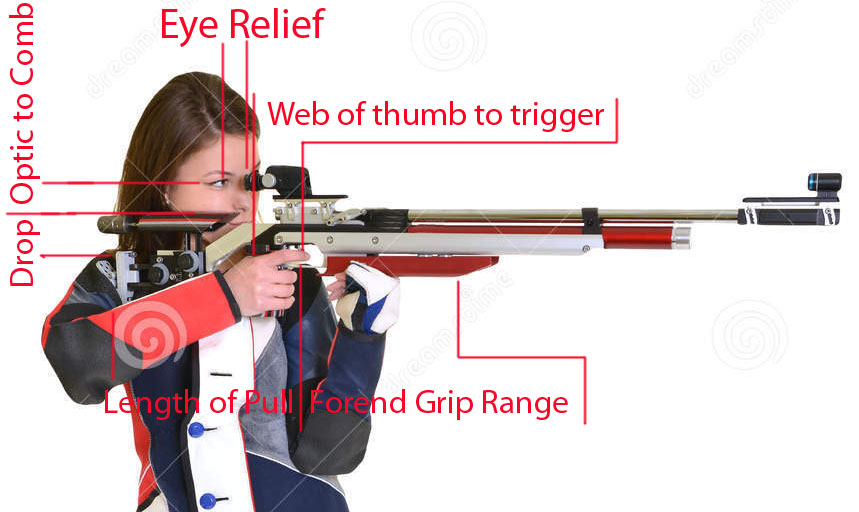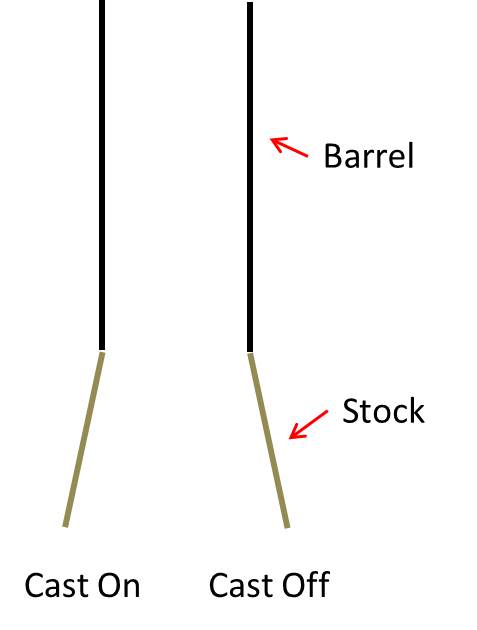Stock Dimensions


This article is not about designing stocks for shotguns. Those designs have some unique components different than our needs, and in fact most of the information you can find online about stock design and dimensions is based on shotgunning. This article is about the design parameters of an air rifle stock.
Many rifle stocks that come on sporting long arm airguns have a shape that is 'normal' looking per an expectation of appearance based on exposure to long arm powder burner stocks. Our airguns often have a completely different shape to them in terms of trigger distance from the scope rail. In an airtube gun with the trigger hanging off the bottom of the tube requires a different shape to fit well.
Optic to Comb Height: To determine your ideal stock dimensions for a given application, start first with the optic to comb height. This dimension is from the top of cheek contact with the comb and the center of the eye looking down the optic. Whether it be a scope or iron sights doesn't make a difference; this is the datum around which the rest of the dimensions come from. I find 2" to be a general average. You can measure your ideal dimension from the center of your eye taken from the outside corner of your eye, down to just under the cheekbone. When making a custom stock, this is the first dimension I draw, so you might check if you like 2" and let me know if you want a different dimension.
Drop is based on the dimension from cheek contact at the top of the comb to the top of the shoulder, and is measured on the stock from the top of the forearm to the top of the butt (using the top of the forearm as a reference datum). Drop determines how much upright the head is, versus laying the head down forward. More drop = more upright head position. Less drop=lower position. Less drop is preferred for recoiling airguns like springers and PCP maybe over 40 fpe where recoil starts becoming noticable. Basically we are raising and lowering the height of the cheek in relation to the shoulder by changing drop. Another factor that can determine maximum drop is what will fit in the blank. If you have a preferred drop, let me know.
Length of pull is really based from where the eye relief and comb height put the head, and where the shoulder ends up in the designed shooting position. Measured from the trigger to the butt as a reference, and the inside the elbow measuring is generally right on the money, but it is important to understand that length of pull is really based on the dimension of the eye to the shoulder with the cheek in contact with the wood and looking down the optic. You can read more about determining length of pull here.
Trigger position is determined from the back of the wrist where the web between the thumb and the index finger, or perhaps just the thumb, rest on the back of the wrist. An average dimension is in the range of 3-3 1/4" inches. It can be estimated by pressing a measuring stick into the web of the hand and measuring to the trigger finger bent at an appropriate angle. Don't forget this angle may be a reaching forward angle so that after pulling the slack out of the first stage the finger is near 90 degrees.
Cast off/Cast on may not always be possible as some airgun stock forearms are so wide they barely fit the width of a standard gunstock blank so the stock can't be cut at much of an angle as viewed from the top, and then additionally with a cheekpiece on one side and maybe a roll over on the other side, the buttstock barely fits (usually right to the surface of the blank with no extra room). Typically cast off/cast on is a feature found on shotguns which are thin enough to allow it, and the shooting requirements of not really using a sighting aid as both eyes are open on the typically moving target require the gun to fit naturally to align the eye along the axis of the barrel. No airgun discipline has that same fit requirement as all airgun discplines require a sighting aid. That said, for a an airgunner with a stock thin enough to allow it, or a blank thick enough, this dimension can be built into the master.
Basically, stock design starts with the eye looking down the optic, from the center of the eye measured down to the cheek is where the top of the comb goes, and from the cheek to the shoulder sets the drop, and eye relief when in the intended shooting position sets the length of pull.